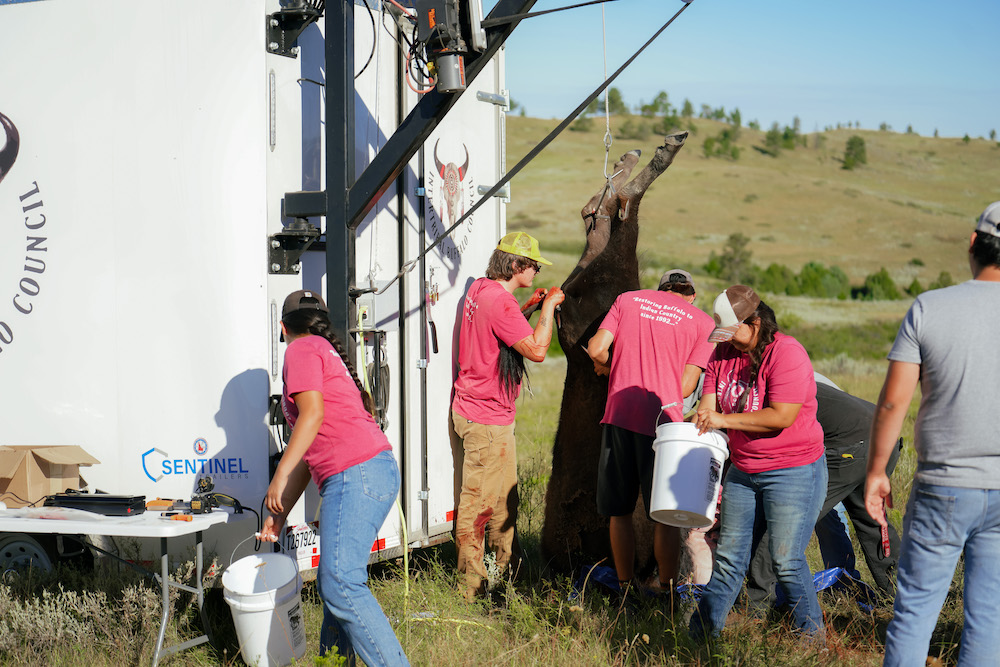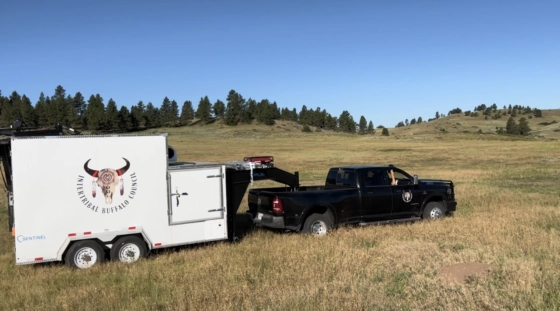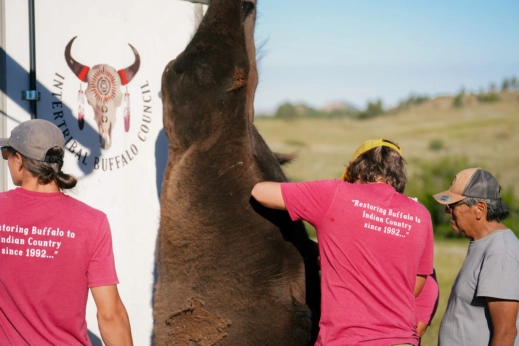A comprehensive round-up of USDA initiatives aiming to restore bison herds to Native American communities.

Last summer, members of the InterTribal Buffalo Council (ITBC), a Native non-profit group dedicated to restoring Tribal bison herds among its 83 member nations, embarked on a timeless practice across the grasslands of southeast Montana: the slaughter of a 1,600-pound American bison, right out in the open prairie.
In tow was the organization’s new “Cultural Harvest Trailer,” a four-wheel vehicle custom-designed to process the sacred bovid in line with Tribal customs—and US Department of Agriculture (USDA) meat-processing standards. Built through a cooperative agreement with the federal agency, the $75,000 prototype is a game-changing innovation, says Troy Heinert, ITBC executive director and a member of the Rosebud Sioux Tribe in South Dakota.
“We can slaughter, skin and quarter an animal in the open, with grass still in his mouth and have him in a cool trailer in 90 minutes,” or half of the processing time allowed by the USDA, says Heinert. The narrow window, which is tailored to the centralized harvesting of cattle and other transport-friendly livestock, can be challenging on Tribal land, he says. Often, “it can take a couple hours just to get to the highway, let alone a processing plant.”
The harvest trailer is one example in a recent set of sweeping USDA initiatives that recognize and promote buffalo—an animal central to the identity of numerous North American peoples—as foundational to Tribal food systems.
Spurred by years of advocacy by the ITBC, the agency’s grant programs and regulatory overhauls reinforce the interwoven nature of bison husbandry, processing and distribution. The shift in perspective helps restore “Tribal buffalo lifeways,” he says, by putting bison back onto local plates and into the local economy.

The ITBC’s Cultural Harvest Trailer rolls across the Crow Reservation in southern Montana. (Photo courtesy of the InterTribal Buffalo Council)
For Native communities, especially those in rural and economically disadvantaged regions, reclaiming their food source is a major leap towards self-determination, says Heinert. “So, this is just a huge win for Tribal people.”
Prairie roots revival
Approximately 30 million American bison once roamed the country’s vast grasslands. But in the mid-1800s, federal policies tied to westward expansion fueled their systematic slaughter, devastating the livelihood of Native Tribes. By 1884, the buffalo population had plunged to just 325 animals, but subsequent conservation efforts have revived those numbers to about 400,000. Heinert estimates that Tribal herds total nearly 30,000; the remainder reside in state and national parks, including Yellowstone, and on commercial ranches.
As a keystone species, buffalo play a vital role in restoring grasslands by enhancing native grass growth. The fertile and highly threatened ecosystem is essential to biodiversity, water filtration, soil stabilization and carbon storage, and fostering them aligns with federal climate and environmental goals. (A recent study finds that, in the face of greater droughts and wildfires, the deep-rooted system can sequester more carbon than forests.)
The USDA’s Partnerships for Climate-Smart Commodities program includes nearly $92 million in bison-related grants. The ITBC is administering $5 million to assist Tribes in implementing climate-resilient, regenerative ranching practices, mainly through extensive fencing and water infrastructure development.
Like many other native animals and plants that have evolved with the land, bison are hardy and climate-resilient, requiring few interventions or inputs to flourish, says Heather Dawn Thompson, the USDA Office of Tribal Relations director and a member of the Cheyenne River Sioux Tribe of South Dakota. As a food source, the bison’s high nutritional content can also help boost health outcomes in communities grappling with diet-related health challenges, making it a key consideration in promoting national food security.
Yet, the USDA’s commodity-centered approach, which favors industrial producers and national distribution models, hasn’t fostered the small-scale production of Indigenous crops and livestock, says Thompson. Bison are a prime example; the undomesticated and free-roaming animals don’t fit the Big Ag paradigm of concentrated feedlots, commodity grain feeding and centralized processing facilities—common livestock practices needed to achieve the scale required to fulfill the 40,000-pound minimums required for USDA meat procurement contracts.
Consequently, “Tribal producers couldn’t even apply to programs that served their own reservations,” says Thompson, such as the Food Distribution Program on Indian Reservations (FDPIR) and other initiatives that comprise the agency’s $3-billion annual spend.
The 2021 American Rescue Plan revamped the rules to accommodate “a more complex and diverse food system,” says Jennifer Lester Moffitt, the USDA’s under secretary of agriculture for marketing and regulatory programs.
In particular, the FDPIR, which includes elder and child nutrition programs, expanded food choices to cover traditional staples such as bison and wild salmon. It also drastically lowered procurement minimums and allowed state meat inspections in place of federal ones. (Bison, being a non-amenable, or wild species, don’t require a USDA seal; however, federal contracts and interstate sales do.)
Last year, the USDA tested these changes through the Bison Purchase Pilot program, awarding half-year FDPIR procurement contracts to four Tribal producers, including $67,000 to the Cheyenne River Buffalo Authority Corporation (CRBAC), a ranching operation owned by the Cheyenne River Sioux Tribe.

ITBC and Crow Tribe members slaughter bison using the ITBC’s Cultural Harvest Trailer on the Crow Reservation in southern Montana. (Photo courtesy of the InterTribal Buffalo Council)
The solid commitment helps “even the field for Native producers,” says CRBAC manager and Tribal member Jayme Murray, whose corporation has kept nearby reservations supplied with 800 pounds of bison meat every month since last November. While the near-10-percent uptick in sales is a boon for business, the profits go far beyond the bottom line, he adds. “A local food system [allows] us to feed our own Tribal communities and put a culturally significant [food] back into our diet.”
The recognition of state inspections also permits procurement opportunities with other federal agencies, as well as access to a national, online market. These changes “bring much-needed revenue and jobs to the Tribe and community,” says Murray, giving an economic boost to a region officially identified as being in “persistent poverty.”
Shoring up the safety net
Sitkalidak Island faces Old Harbor, a remote village of 235 residents—mostly from the Alutiiq Tribe of Old Harbor, a Native Alaskan people—in Alaska’s Kodiak Archipelago. Rugged and verdant, the uninhabited isle has long been a rich hunting ground for brown bears, Sitka deer and ducks, while the surrounding seas have provided the Alutiiq with abundant salmon, halibut, butter clams and seals. Yet, depleting fish stocks, increasing algal blooms and crashes in the deer population have made those traditional food sources less reliable in recent years, says Jeffrey Peterson, Alutiiq chief and city mayor.
In 2017, the Tribal Council acquired 30 buffalo with support of the ITBC as a means of enriching the local diet. For an isolated community with no grocery store—the closest is a 40-minute flight away in Kodiak City—the herd, which has grown to about 70 heads, has become crucial to Tribal food security. “They can survive the bears and the winters,” says Peterson. “And as Native people, we feel a connection to bison or any indigenous animal that may have roamed our [North America] lands.”
Currently, the Alutiiq harvest about two heads a month for local consumption. But without a processing and refrigeration facility, handling and storing the carcass of the continent’s largest land mammal—a mature bull can stand 6.5 feet tall and weigh upwards of 2,000 pounds—is a challenge, says Peterson.
The long-awaited approval of the Indigenous Animals Harvesting and Meat Processing Grant, a USDA program designed to bolster the processing, storage and distribution infrastructure of culturally relevant meat in Native communities, will be transformative, says Peterson. The $1-million grant secures the purchase and modernization of an existing warehouse—and with electricity costing more than four times the national average, will help keep it running.
The ability to process and stock ample buffalo and other locally sourced meats and fish helps shore up the safety net of the entire Tribe, he says, including expats in Kodiak City, Anchorage and beyond. It also opens up opportunities for new jobs, food exports and increased tourism by catering to more recreational hunters and fishermen.
“You can’t stop… changes in the climate, the acidification in the ocean,” says Peterson. “Without a backup plan, we’re going to be hurting.”
Together, the comprehensive nature of these initiatives recognizes the centrality of bison in restoring both the land and Native food sovereignty, says ITBC’s Heinert. “The buffalo was nearly decimated in order to control the Native people of this country. Now, [we’re able to] bring this animal back to its rightful place, in its rightful numbers… all the while helping to heal our lands,” he adds. “It’s starting to come full circle.”
***
How to support Tribal buffalo efforts
Although Tribal ranchers and advocates see the economic potential of bison, they’re quick to dismiss the notion of turning it into a cattle-like commodity. Bison ranching runs counter to high-volume, mass production, says Dave Carter, regional director of the Flower Hill Institute (FHI). The Indigenous-led nonprofit partners with the USDA to assist Tribes with grant applications and project implementation, including bison processing, marketing and distribution.
As wild animals, buffalo are raised as nature intended—on vast open land, in natural herds that include bulls. They’re spared standard livestock practices such as castration, artificial insemination and confinement in feedlots, says Carter, who previously headed the National Bison Association, a trade group representing the interests of commercial bison producers and processors.
While these factors can limit the size of operations, “we have a lot of room to grow to herds without [it] becoming a commodity,” he says. Although Americans eat, on average, 59 pounds of beef annually, per-capita buffalo consumption equates to mere nibbles of a single burger.
“The best way to preserve bison,” Carter adds, “is to eat bison.”
For a Tribal source, check out the Cheyenne River Buffalo Company.


These people should really find someone who knows how to properly slaughter to show them how to do it. Skinning it in the air, and not even getting legs off before hanging it makes it exponentially harder on yourself. Animal should be propped up on its back, legs removed and skinned down the sides first before hanging it. Hanging to skin just means you’re chasing it.
This is sad…enough with the killing and eating of animals regardless of culture or justification….there are so many different sources of food…if you want to re-install a culture go back to the horse 🐎 and bow and arrow…I support all things of Native People…just not the killings.